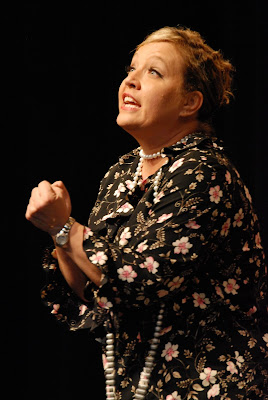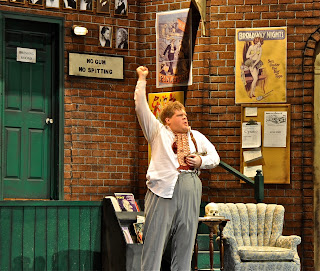story and photos by janet i. martineau
Hopefully Saginaw Valley State University theater majors Rusty Myers and Lexee Longwell arrived today (April 16) in Washington, D.C.
That is if he cleared airport security with his 5-pound, oversized, complete and annotated works of Shakespeare tome that he carries everywhere with him. Might make him appear a little suspicious, along with his scraggly reddish beard and mustache.
 |
| Rusty Myers, Lexee Longwell are in a national theater competition |
But Myers, 27 -- and his “partner” Longwell, 20 -- are all business, theater business, as they travel in a rarified atmosphere.
He is one of only 16 finalists from an estimated 2,000 contestants vying for a prestigious Irene Ryan Foundation Scholarship at the national Kennedy Center/American College Theater Festival.
It is a first for the SVSU theater program, placing a Ryan finalist in the nationals. And also a bit of a shock to Myers, who for three years shorly after high school worked as a laborer for Gerace Construction in Midland before he finally settled down in college AND discovered theater.
“First of all, my high school (Breckenridge) did not do plays when I was a student so I had never acted until I came to SVSU four years ago,” he says with a grin.
“And when I was at Gerace, I worked with the precast crew on Dow Diamond (the home of the Loons baseball team, in Midland), so that stadium has a majority of that work done by the crew I was on.”
But back to the his trip to D.C. this week.
The Kennedy Center/American College Theater Festival consists of eight regionals leading to this week’s national, and at the regional Myers competed against 300 other Ryan hopefuls. From that, two were chosen to go to the national -- hence the number 16 competing at the end of this week.
Each Ryan has a “partner” who is required for the scenes nominees do at the competition. And while that partner does not get an Irene Ryan scholarship award, he or she is eligible for plenty else.
“There is a best partner award,” says Longwell. “At the regional I got as many comments from the judges as Rusty did, which is helpful as an actor. And at the national I can attend all the workshops it offers, and can audition with the theater companies attending the festival and offering fellowships or internships.”
In fact, both she and Myers have auditions already scheduled for a scholarship with the Shakespeare Theatre Company.
“During each day of the festival, we will spend three or four hours with casting agents, production companies,” says Myers. “And actually they are watching us the whole week, from the minute we get off the plane to the Ryan competition on Friday. They are checking out everything about us -- how much we participate as well as the acting skills.
“The nationals is called a fast forward on theater careers because of who attends it looking for talent to recruit.”
And Longwell, a sophomore at SVSU, says she would quit college in a second if she gets an offer “because I can always go back to college and finish my degree.”
Both plan to “just have fun” at the national, which is also how they approached the regional, which took place at SVSU in January.
“We danced and laughed and had a blast all the way through,” she recalls. “I think I was the least nervous I have been for anything.”
They were, she recalls, an exception when compared to some really tense Ryan teams.
Myers had been a regional Ryan competitor for his first three years at SVSU and she last year “and nothing happened beyond the first of the three rounds then, soooooo,” says Myers, “so I was on borrowed time for anything to happen and thought it would be icing on the cake to maybe at least make it to the semi-finals (the second round) and that would be OK. And we’d just have fun with it.”
 |
| Rehearsing a scene from "Rex" |
Imagine the surprise when it was announced they were in the finals.
Says Longwell, “I was sobbing hysterically and was screaming through the hallways (at SVSU), ‘Where is my partner, where is my partner,’ because with the announcement we had to attend an immediate meeting.”
Well, he was in downtown Saginaw, delivering a festival participant to the Montague Inn...and quickly rushed back via a cell phone message.
“That was when the gravity hit me,” recalls Myers. “Holy cow I could win this thing. This is when it became real -- I might end up representing my university, winning against some Big 10 schools in five states (Illinois, Ohio, Indiana, Wisconsin and Michigan).”
After the third round/finals came a wait to see which two teams would go to the national.
Myers and Longwell were hopeful since the three judges in the final round had nothing but praise for them, and in fact went beyond the alloted time carved out for evaluations.
And when they were announced as winners, in a ceremony at the Temple Theater, “well, I was sobbing hysterically again,” says Longwell. “Apparently that is what I do.”
As the regional competition is structured, in the first round the team does one scene; in the semifinals two scenes, and in the final round two scenes and a monologue by the Ryan nominee. No more than six minutes total in that final round; less in the first two.
In the first they did “Rex” by Joe Pintaro, dealing with a roadkill dinner; in the semi-final “Rex” again and “Gruesome Playground Injuries” by Rajiv Joseph, about a struggling couple; and in the final those two scenes plus his monologue from a Christopher Marlowe work.
Acting majors are chosen as Ryan competitors from plays their colleges stage -- by traveling adjudicators and a director at their college. Myers was chosen for his role as George in “Who’s Afraid of Virginia Wolf?” and in turn he chose Longwell as his partner. And from then both choose their own competition material, schedule their own rehearsals and mostly self-direct, says Myers.
“How it works is that the faculty does not ask you if you want their help, you ask them,” he says. “That is part of the competition -- that you have a strong work ethic but can ask their advice.
“Lexee and I have a great stage presence I think. We are friends and get along well.”
Adds Longwell, “They pick students who are headed in the right direction for success.”
Myers received $500 in scholarship money for the regional win and would receive $2,500 if he wins at the nationals.
 |
| OK, who blew the line this time! |
After graduation this spring, Myers says he is ready to start getting paid for acting, “to get some professional experience under my belt,” so will not go to graduate school at this point.
Being a country kid who likes to hunt and fish, he is eyeing theater companies in the Pacific Northwest -- from California to Washington, He acted in upwards of 20 plays at SVSU, from the lead in the comedy “Moon Over Buffalo” to the evil Stanley in “Streetcar Named Desire.”
“Streetcar,” he says, was the turning point for him as an actor. He knew the work as an English major, had in mind a minor role when he auditioned, and in no way wanted to be compared to Marlon Brando who played Stanley.
When he was cast as Stanley, in his sophomore year, “I knew I would either drop the ball or score a touchdown. It was my first role as a reprehensible villain, having always played a sidekick before.
“What I learned was you have to find empathy for your character, no matter how bad he is, or the performance will not come off.”
In Stanley’s life, he says, only his wife Stella made sense to him, and when her sister Blanche arrives “she threatens to take that all away from him, so he has to destroy her. He would not have turned violent but his ‘property’ was threatened.”
It earned him one of his four selections as a Ryan competition nominee.
Longwell, from Howell, has been in five plays so far at SVSU and started acting at age 4 “when I was in ‘Noah’s Ark’ as a duck with one quack.” Her family is big on theater, and it was her mother who found out SVSU offered distinguished theater scholarships. So she applied and won.
In her future, Longwell would like to work in children’s theater and eventually teach at the college level. She was a Ryan nominee in her freshman year as Mammy in “Wiley and the Hairy Man.”
As for Myers and his route to a theater career, the short version is after high school he tried another college and it didn’t work, so he headed for Gerace. He was “dating someone” when he decided to go back to college, she was headed to SVSU, he followed. Up to then he was into sports, hunting, fishing.
At SVSU, he says, said former girlfriend took Introduction to Acting, so as an English major he did also, the professor (Ric Roberts) saw a glimmer of something, and before he knew it he auditioned for a play and was cast in it (“Why Do Fools Fall in Love”).
“And from that my world in theater took off.”










